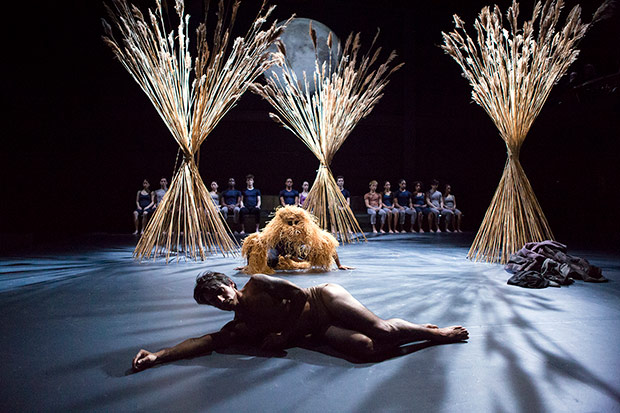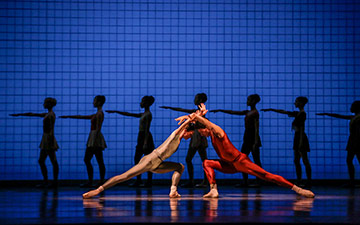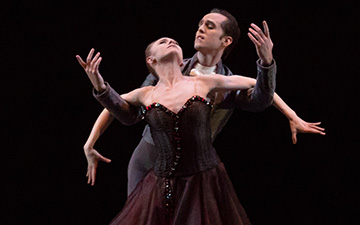
© Rebecca Greenfield. (Click image for larger version)
Jerome Robbins – re-imagined by Luca Veggetti
Watermill
★★★✰✰
New York, Brooklyn Academy of Music
25 October 2018
jeromerobbins.org
www.facebook.com/luca.veggetti.3
www.bam.org
Time Flies
I can’t say I was dying to see Jerome Robbins’ Watermill again, even though ten yeas had passed since my last glimpse of it at the big Robbins festival at New York City Ballet in 2008. This year’s centennial at City Ballet excluded it – as well as the lovely and imaginative Mother Goose, which I miss much more – and one can see why. With its glacial tempi, Japanese trappings, and extremely minimal content, it’s a hard sell. It’s also difficult to program; what do you put before or after a slow-motion dream ballet set to Japanese music, in which the protagonist barely moves?
I was drawn to the Brooklyn Academy of Music re-staging, running through Oct. 27, by three things. Firstly, the prospect of seeing Joaquin de Luz, just retired from New York City Ballet, in a work so completely different from the kind of high-energy, bravura roles he specialized in at the company. Secondly, by my curiosity regarding Luca Veggetti’s new setting of the work in a small black box theatre (the Fishman Space), with the audience sitting on three sides of the stage. And finally by the idea of seeing it as a stand-alone piece, neither followed nor preceded by another ballet, executed in a jarringly different style. This seemed, somehow, like the right way to experience Watermill.
And I was happy to discover that, yes, in fact, something about this more intimate, immersive setting did alter the work’s energy and rhythm, its overall feel. Luca Veggetti has made subtle changes, without fundamentally altering the content or dynamics of the piece. All the main elements are there: a man, at first wearing a cloak, then nearly naked, remembers or dreams of episodes from his life. Some are beautiful, others erotically charged, or painful. He is buffeted by them – his body responds, as it does when we are trapped in a dream.

© Rebecca Greenfield. (Click image for larger version)
Originally, the ballet was created for Edward Villella, for whom Robbins had already imagined the role of man in brown in Dances at a Gathering. Like De Luz, by the time Villella got around to doing Watermill, he was at the end of his career, his body marked by years of hard work. Though the character moves little, mainly lunging and reaching and rolling and reclining, the role requires a deep, unrelenting focus and a complete simplicity and truthfulness of movement. The dancer can’t drift for a moment or look false, without immediately breaking the spell. Sitting up-close at the Fisher, it was possible to really enter his world, almost see it through his eyes.
The musicians, on Japanese bamboo flute, gongs, bells, drums, and a dulcimer-like instrument, sat on a platform above and to the right of the stage, playing Teiji Ito’s score. A row of dancers, students from the Conservatory of Dance at Purchase College, sat on a long bench in the back, occasionally rising to enter the story. Three sheaves of grasses formed a triangle in the middle of the space, elegant, totem-like.
Slowly, as in a Noh play, dancers entered the space, alone or in groups, to act out the man’s memories. A youth, perhaps a younger version of the protagonist, joined a pack of young men running around the stage, like athletes in training. They didn’t seem to see this figure sitting on the ground, simply swarming around him like a flock of birds. Later, a young woman stripped down to her bathing suit, as if to sunbathe, and was then joined by a man, with whom she silently tangled in a slow, impersonal erotic exchange. At the end, De Luz replaced the man, resting his head on the woman’s lap. After the lovers had departed, a masked, dog-like creature – a demon? – attacked De Luz, whose body flailed and recoiled. Farmers sat around a basket; harvesters cut down stalks of grass. Each episode seemed to float outside of time, almost in a different dimension. And yet, there was feeling, mostly a kind of desolation, or regret. De Luz made it clear, without over-emoting, that this man’s memories were not happy ones.

© Rebecca Greenfield. (Click image for larger version)
In the final chapter of what had come to feel like a ceremony of remembering, De Luz took two of the stalks and held them like magical talismans, crossing them behind his neck, lunging forward in a final offering. Then, as a shower of snow fell from the sky – a bit of a cliché – and a hooded figure stalked the stage, De Luz covered himself once more, and it was over.
One is left to wonder why Robbins decided to cloak his memory poem in these Japanese trappings, creating an artificial frame for what is at heart an intensely personal story. The device is estheticizing, but also distancing; why are these people wearing Southeast Asian straw hats? Why are there the Japanese kites and lamps and bamboo flutes and chanting? It’s almost as if this great man of the theatre couldn’t resist showing off just a little, even here.
Veggetti has done what he could to make us believe in this world. The intimacy and proximity to the performers help. De Luz’s straightforward, focused performance registered with an intensity I don’t remember from that performance I saw ten years ago at Lincoln Center. He, and the other performers, looked extremely moved at the end. This extreme stillness, silence, stylization, clearly touches something deep in them. And through them, despite the japoniserie, we feel it too.

















Thank you Marina —
I did not get to see it, and your writing is so clear and compelling. I wish I had been there…